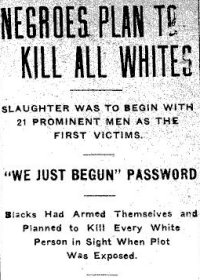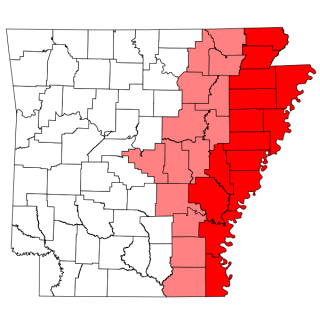
DeSoto County is a county located on the northwest border of the U.S. state of Mississippi. As of the 2010 census, the population was 161,252, making it the third-most populous county in Mississippi. Its county seat is Hernando.

Desha County is a county located in the southeast part of the U.S. state of Arkansas, with its eastern border the Mississippi River. As of the 2010 census, the population was 13,008. It ranks 56th of Arkansas's 75 counties in terms of population. The county seat is Arkansas City. Located in the Arkansas Delta, Desha County's rivers and fertile soils became prosperous for planters under the cotton-based economy of plantation agriculture in the antebellum years and late 19th century. Still largely rural, it has suffered population losses and economic decline since the mid-20th century.

Elaine is a very small town in Phillips County, Arkansas, United States, in the Arkansas Delta region of the Mississippi River. The population was 636 at the 2010 census.

Clarksdale is a city in and the county seat of Coahoma County, Mississippi, United States. It is located along the Sunflower River. Clarksdale is named after John Clark, a settler who founded the city in the mid-19th century when he established a timber mill and business.

The Elaine massacre or Elaine race riot, occurred on September 30–October 1, 1919 at Hoop Spur in the vicinity of Elaine in rural Phillips County, Arkansas. Some records of the time state that 100-300 African-Americans and five white men were killed. Estimates of deaths made in the immediate aftermath of the Elaine Massacre by eyewitnesses range from 50 to "more than a hundred". Walter Francis White, an NAACP attorney who visited Elaine shortly after the incident stated "... twenty-five Negroes killed, although some place the Negro fatalities as high as one hundred". More recent estimates of the number of black people killed during this violence are higher than estimates provided by the eyewitnesses, recently ranging into the hundreds. The white mobs were aided by federal troops and terrorist organizations like the Ku Klux Klan. According to the Encyclopedia of Arkansas, "the Elaine Massacre was by far the deadliest racial confrontation in Arkansas history and possibly the bloodiest racial conflict in the history of the United States".

The Mississippi Delta, also known as the Yazoo–Mississippi Delta, or simply the Delta, is the distinctive northwest section of the U.S. state of Mississippi which lies between the Mississippi and Yazoo Rivers. The region has been called "The Most Southern Place on Earth", because of its unique racial, cultural, and economic history. It is 200 miles (320 km) long and 87 miles (140 km) across at its widest point, encompassing about 4,415,000 acres (17,870 km2), or, almost 7,000 square miles of alluvial floodplain. Originally covered in hardwood forest across the bottomlands, it was developed as one of the richest cotton-growing areas in the nation before the American Civil War (1861–1865). The region attracted many speculators who developed land along the riverfronts for cotton plantations; they became wealthy planters dependent on the labor of enslaved African Americans, who composed the vast majority of the population in these counties well before the Civil War, often twice the number of whites.

The Farmers Alliance was an organized agrarian economic movement among American farmers that developed and flourished ca. 1875. The movement included several parallel but independent political organizations — the National Farmers' Alliance and Industrial Union among the white farmers of the South, the National Farmers' Alliance among the white and black farmers of the Midwest and High Plains, where the Granger movement had been strong, and the Colored Farmers' National Alliance and Cooperative Union, consisting of the African American farmers of the South.

The Southern Tenant Farmers' Union (STFU) (1934–1970) was founded as a civil farmer's union to organize tenant farmers in the Southern United States.

LeRoy Percy was an attorney, planter, and politician in Mississippi. In 1910, he was elected by the state legislature to the US Senate and served until 1913.
The Hanapēpē Massacre occurred on September 9, 1924 when an interethnic dispute amongst Filipino strike organizers in Hanapēpē, Kaua'i resulted in a violent exchange between local police officers and Filipinos. The conflict began when two Ilocano youth, allegedly breaking the Filipino-led labor strike, were detained and harassed by a group of Visayans at the Hanapepe strike camp. When the local police were called to settle the dispute, they arrived with a group of heavily armed special deputies. Upon arrival, the officers issued warrants of arrest for the two detained Illocanos, causing the collection of Filipinos strikers to rally in opposition. Despite previously ridiculing the two Ilocanos, the remaining Filipinos armed themselves and demanded the boys be released. A violent exchange ensued wherein sixteen Filipino laborers and four police officers were left dead.
Colored Farmers' National Alliance and Cooperative Union was formed in 1886 in Texas. Despite the fact that both black and white farmers faced great difficulties due to the rising price of farming and the decreasing profits which were coming from farming, the protective organization known as the Southern Farmers' Alliance did not allow black farmers to join. A group of black farmers decided to organize their own alliance, to fill their needs. The organization rapidly spread across the Southern United States, peaking with a membership of 1.2 million in 1891.

The New Orleans general strike was a general strike in the U.S. city of New Orleans, Louisiana, that began on November 8, 1892. Despite appeals to racial hatred, black and white workers remained united. The general strike ended on November 12, with unions gaining most of their original demands.

The Memphis sanitation strike began on February 12, 1968, in response to the deaths of sanitation workers Echol Cole and Robert Walker. The deaths served as a breaking point for more than 1,300 African American men from the Memphis Department of Public Works as they demanded higher wages, time and a half overtime, dues check-off, safety measures, and pay for the rainy days when they were told to go home. The Memphis sanitation strike was led by T.O. Jones and had the support of Jerry Wurf, president of the American Federation of State, County, and Municipal Employees (AFSCME) and the local branch of the National Association for the Advancement of Colored People (NAACP). The AFSCME was chartered in 1964 by the state, the city of Memphis refused to recognize it. Resulted in the second sanitation Worker Strike in 1968 which began because of several incidents that led the employees to strike. Mayor Henry Loeb refused to recognize the strike and rejected the City Council vote, insisting that only he possessed the power to recognize the union. The Memphis sanitation strike prompted Martin Luther King Jr.'s presence, where he famously gave the “I’ve Been to the Mountaintop” speech a day before his assassination.

The Arkansas Delta is one of the six natural regions of the state of Arkansas. Willard B. Gatewood Jr., author of The Arkansas Delta: Land of Paradox, says that rich cotton lands of the Arkansas Delta make that area "The Deepest of the Deep South."

The Memphis massacre of 1866 was a series of violent events that occurred from May 1 to 3, 1866 in Memphis, Tennessee. The racial violence was ignited by political and social racism following the American Civil War, in the early stages of Reconstruction. After a shooting altercation between white policemen and black veterans recently mustered out of the Union Army, mobs of white residents and policemen rampaged through black neighborhoods and the houses of freedmen, attacking and killing black soldiers and civilians and committing many acts of robbery and arson.

A plantation complex in the Southern United States is the built environment that was common on agricultural plantations in the American South from the 17th into the 20th century. The complex included everything from the main residence down to the pens for livestock. Southern plantations were generally self-sufficient settlements that relied on the forced labor of enslaved people.

The Thibodaux massacre was an episode of racial violence that occurred in Thibodaux, Louisiana on November 23, 1887. It followed a three-week strike during the critical harvest season in which an estimated 10,000 workers protested against the living and working conditions which existed on sugar cane plantations in four parishes: Lafourche, Terrebonne, St. Mary, and Assumption.

The California agricultural strikes of 1933 were a series of strikes by mostly Mexican and Filipino agricultural workers throughout the San Joaquin Valley. More than 47,500 workers were involved in the wave of approximately 30 strikes from 1931-1941. Twenty-four of the strikes, involving 37,500 union members, were led by the Cannery and Agricultural Workers' Industrial Union (CAWIU). The strikes are grouped together because most of them were organized by the CAWIU. Strike actions began in August among cherry, grape, peach, pear, sugar beet, and tomato workers, and culminated in a number of strikes against cotton growers in the San Joaquin Valley in October. The cotton strikes involved the largest number of workers. Sources vary as to numbers involved in the cotton strikes, with some sources claiming 18,000 workers and others just 12,000 workers, 80% of whom were Mexican.

The role of African Americans in the agricultural history of the United States includes roles as the main work force when they were enslaved on cotton and tobacco plantations in the Antebellum South. After the Emancipation Proclamation in 1863-1865 most stayed in farming as very poor sharecroppers, who rarely owned land. They began the Great Migration to cities in the mid-20th century. About 40,000 are farmers today.
The lynching of Henry Lowry, on January 26, 1921, was the murder of an African-American man, Henry Lowry, by a mob of white vigilantes in Arkansas. Lowry, a tenant farmer, had been on the run after a deadly shootout at the house of planter O. T. Craig on Christmas Day of 1920. Lowry went into hiding in El Paso, Texas; when he was discovered and extradited by train, a group of armed white men boarded the train in Sardis, Mississippi, and took Lowry to Nodena, near Wilson, Arkansas. He was doused in gasoline and burned alive before a mob of 500. A reporter from the Memphis Press witnessed the event, and word of the lynching soon spread around the country, aided by an article William Pickens wrote for The Nation, in which he described eastern Arkansas as "the American Congo".

















